Initial release ghost: 2023-08-15
After experiencing the death spiral of Gamefi, the market in 2023 has shifted its focus more towards full-chain games, with Starknet currently being the most richly developed ecosystem for full-chain games. So, why has Starknet gained the support of numerous full-chain game projects? What advantages does it have in developing full-chain games? And which projects are worth our attention? This article will delve into these questions.
For those who are not yet familiar with full-chain games as a whole, you can first read Uncle Jian's previous article "Nine Questions about Full-Chain Games."
Advantages of Starknet in Developing Full-Chain Games
On social media, Starknet has gradually been labeled as the "most popular development platform for full-chain games." In addition to Loot Realms, which announced its migration from Arbitrum to Starknet in 2021, there are also multiple full-chain game projects such as Cartridge, Influence, Matchbox DAO, Briq, and Cafe Cosmos.
What advantages does Starknet have that make it so popular among full-chain games? The author believes it has the following points:
Continuously Expanding Performance Advantages (High TPS, Low Gas)
Because in full-chain games, the blockchain serves as the game's server, and all player actions need to be completed through interaction with smart contracts, a blockchain must meet the performance requirements of high TPS and low Gas in order to develop a full-chain game ecosystem. The continuously upgrading Starknet has the potential to meet these requirements.
From a fundamental algorithm perspective, the core algorithm STARK used by Starknet is more suitable for large-scale computing applications. Its average verification time and proof size will decrease as the verification scale increases. As shown in the graph below, when there are 3072 hash invocations, the verification time is 40 milliseconds, averaging 76.75 times per millisecond; when there are 49152 hash invocations, the verification time is approximately 60 milliseconds, averaging 819.2 times per millisecond, and the proof size follows the same pattern. Therefore, in creating large-scale full-chain games, the advantages of the STARK algorithm are obvious, and it can achieve high TPS.
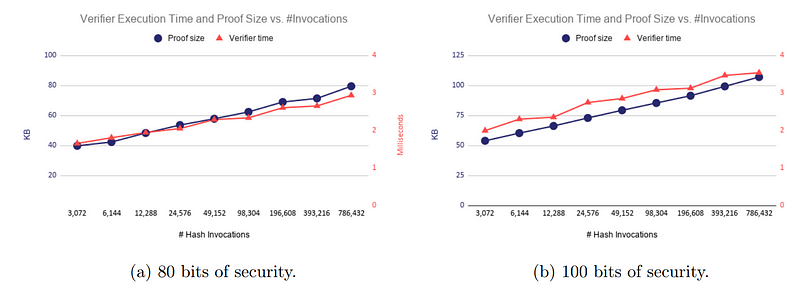
Linear graph of verification time and proof size under different levels of security with hash invocations
At the same time, the recursive proof used by STARK also helps to reduce the on-chain verification cost. In short, recursive proof can compress multiple "upstream" STARK proofs into one proof, and the on-chain only needs to verify the validity of multiple "upstream" proofs through the aggregated single proof, further reducing the Gas for each transaction.
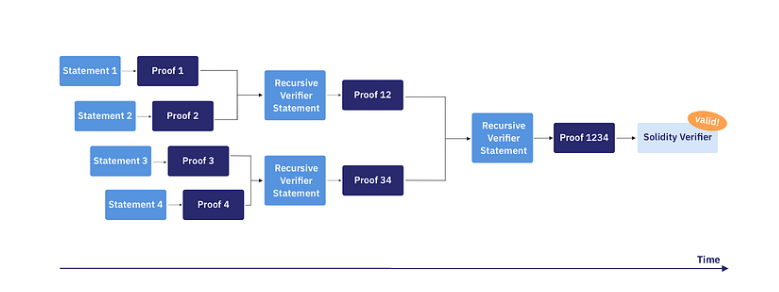
Typical recursive proof process
From the actual team actions, Starknet's Quantum Leap upgrade is also in full swing. The mainnet has been upgraded to version V0.12.0, and the testnet has launched V0.12.1, achieving a significant improvement in TPS. The transaction cost will also be continuously optimized in the future.
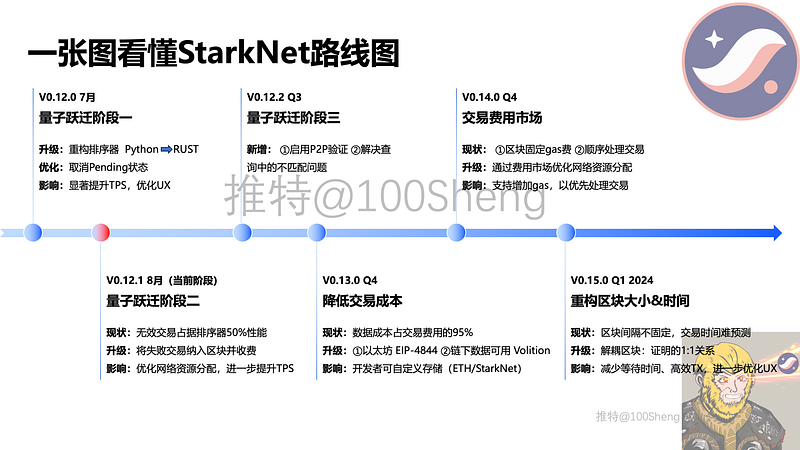
Starknet upgrade roadmap (Source: Twitter user @100Sheng)
Infinite Possibilities of Native Account Abstraction in Enhancing User Experience
If the requirement for blockchain performance is a factor that has constrained the development of full-chain games from a hardware perspective, then from the user's perspective, what has constrained the development of full-chain games more than Gamefi is the poor user experience.
Take the recent popular game Loot Survivor as an example. Every time a user performs an "attack," "escape," or "upgrade" operation, they need to pop up their wallet to sign and authorize the transaction, which is quite cumbersome. Moreover, this is just a lightweight small game. If a large-scale multiplayer full-chain game has the same experience, then there is no need to further discuss its playability.
So, how does Starknet solve such problems for full-chain games? The answer is native account abstraction. Unlike Ethereum's dual account model (EOA and CA) design, Starknet has only one type of account design called "account contract," and it has implemented native account abstraction based on ERC-4337.
For those who are not familiar with the concept of account abstraction, you can read Uncle Jian's previous article "Account Abstraction: Simplifying Your Encrypted World."
Specifically, at a hackathon organized by the Briq, Loot Realms, and Topology teams a year and a half ago, a creative feature called session key was designed using Starknet's native account abstraction, which allows users to perform operations in full-chain games without needing to sign for each one.
This feature has been applied this year as well. On August 7th, the Realms team developed the first implementation of the arcade account using the session keys feature. In the demonstration video of the Loot Survivor game using the arcade account released by the Loot Realms team, it is evident that it enhances the user experience: no need to sign for each "attack," and no need to wait for a long time.

Of course, Starknet's native account abstraction for enhancing the user experience in full-chain games goes far beyond just the session key feature, and there will be more possibilities in the future.
Encrypted Game Engine: Dojo
As we all know, the game engine is crucial for game development. With its support, developers do not need to create basic systems (physical simulation, graphic rendering, and basic game mechanics) from scratch for each game, allowing the saved costs and time to be better invested in innovating game content.
To a certain extent, the reason why traditional commercial games have developed so extensively can be attributed to two major game engines: Unity and Unreal Engine. Most of the games we are familiar with, such as "Fortnite" and "Hearthstone," are developed based on them.
From the perspective of developers, in order to promote the formation of a large-scale full-chain game ecosystem, there should be an engine that helps developers reduce the difficulty of game development. Therefore, in February of this year, the first full-chain game engine on Starknet, Dojo, was officially born through joint research and development by Loot Realms, Cartridge, and Briq.
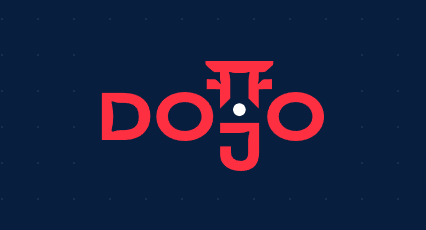
However, unlike traditional game engines, Dojo currently does not involve advanced functions such as physical simulation and 3D rendering, because the development of full-chain games is still in its early stages, and it faces more problems related to interaction with the underlying blockchain. Therefore, according to the official statement, Dojo is focusing on development in four directions:
- Building a game-specific L3 to further improve on-chain performance;
- Running fraud proofs in the game, allowing players to not wait for on-chain verification for every step, improving game smoothness;
- Executing partial proofs locally on the player's device and only uploading the key ZK proofs to the chain, greatly enhancing game performance and player privacy protection;
- Using storage proofs for shared assets, similar to oracles, providing evidence of information authenticity without the need for third-party intervention, proving ownership of assets from different chains through storage proofs, and allowing users to use their assets in different games on different chains.
As the foundation infrastructure for game development, game engines have always played a key role in the virtuous cycle of "helping developers build games, producing hits, and attracting more developers." With the development of Dojo, it is believed that the full-chain game ecosystem advantages of Starknet will become increasingly apparent.
Cairo: A Programming Language Friendly to Complex Full-Chain Game Development
Before Dojo, there was another big brother in the full-chain game engine: MUD. And in terms of ecosystem quantity and technical maturity, MUD currently basically outperforms Dojo.

So, why do we still need Dojo? One of the biggest reasons is that, unlike MUD, which uses the Solidity language, Dojo uses a programming language that is more friendly to complex full-chain game development: Cairo.
Cairo is an intelligent contract language based on STARK and exclusive to Starknet. While there is a certain learning curve for developers accustomed to using Solidity, Cairo is considered more modern compared to Solidity and is similar to the Rust language, providing more advanced and abstract functionality.
For example, the generation of STARK proofs, the reduction of on-chain verification costs through recursive proofs, and the execution of partial proofs locally by players are all implemented through Cairo. Additionally, Cairo is more versatile than Solidity; it is not only suitable for contract development on Starknet but can also run provable programs on other large servers or personal devices, with broader future applications.
Therefore, for complex full-chain games such as large-scale multiplayer online games, Cairo will have a stronger advantage. This will also attract more developers to realize their complex and highly playable full-chain game dreams on Starknet.
Inventory of Projects Worth Paying Attention To
Having understood the advantages of Starknet in developing full-chain games, let's take a look at the projects worth paying attention to in the current Starknet full-chain game ecosystem.
Loot Survivor
Loot Survivor is a lightweight small game launched by Loot Realms, currently running on the Starknet testnet.
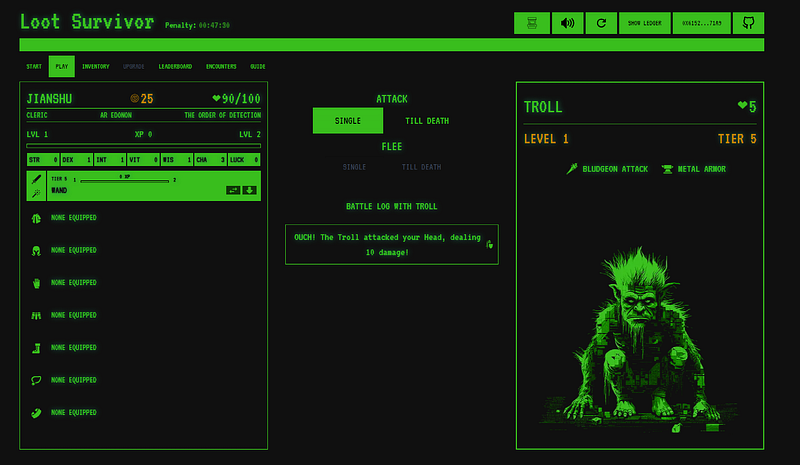
- Play to Die Mode
Different from the various "X to Earn" modes used in Gamefi, Loot Survivor uses the "Play to Die" mode designed by the Loot Realms team. Simply put, players need to spend a small amount of funds to forge an on-chain adventurer character. If the adventurer dies in the game, their life will be confiscated, and the player will need to create a new character and start the game again. There is currently no appropriate Chinese translation that vividly expresses this mode, so the author temporarily translates it as "Fight to the Death" or "Battle to the End."
Compared to the "Play to Earn" mode, which attracts greedy players through wealth creation, the "Play to Die" mode is more sustainable and can prosper the creator ecosystem. In this mode, if an adventurer dies in the game, the creator of the game will receive a dividend from the funds used to forge the adventurer at the beginning.
Therefore, in the "Play to Die" mode, the quality and popularity of the game will determine the developer's reward. If the game is not fun, players will not forge on-chain characters, and the game developers will not receive rewards. This mode will help create a positive, thriving, bilateral market for both players and creators.
After Loot Survivor goes live on the mainnet, it may use its native token $Lords to forge on-chain characters, empowering its token.
Influence
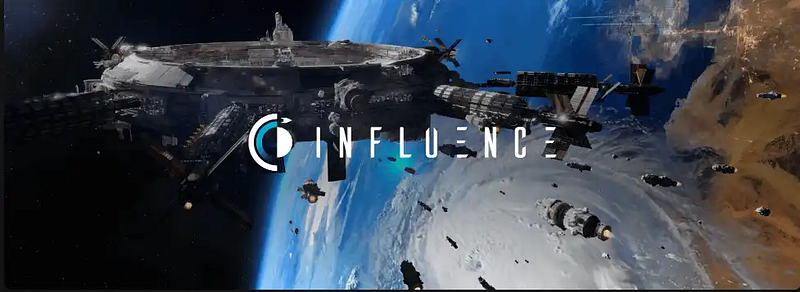
Influence is the most popular large-scale multiplayer space strategy game on Starknet, currently running on the testnet. According to the game's design, players can colonize asteroids, build infrastructure, accumulate resources, and engage in battles with other players. However, overall, this game is not as easy to operate as Loot Survivor, and the author encountered many issues during the experience.
- Team Situation
Founder Chris Lexmond has served as the CTO and VP of Technology for several tech startups, and other team members also have professional backgrounds in creating AAA games. As a startup team, they have promising capabilities.
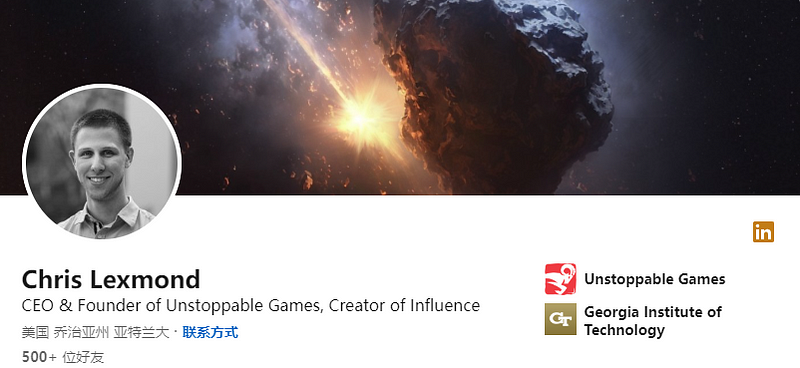
The project team has also stated that when their native token SWAY is issued, 1% will be used to reward testnet participants.
Briq
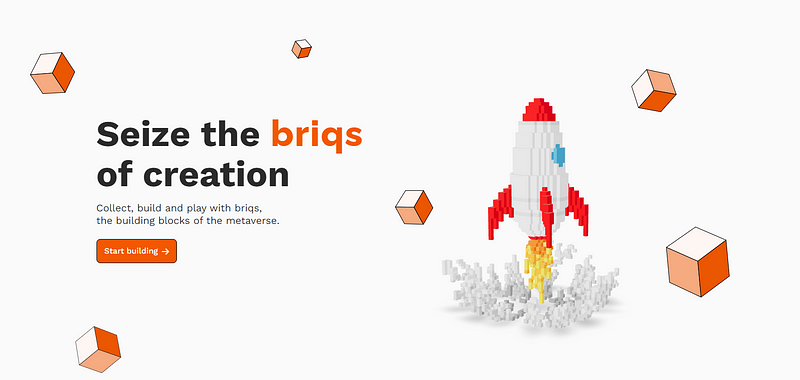
Briq can be likened to an on-chain LEGO system, where players can freely use blocks to build their desired structures and can also forge their models into an NFT. If they wish, they can also reassemble or disassemble the forged NFT, showing a high degree of composability.
Briq actually has great potential; it is more like a fundamental protocol and can be fully integrated with a full-chain game in the future, allowing users to use the NFTs they forge on Briq in the game.
Cartridge

Cartridge is a full-chain game integration platform on Starknet, often compared to the Steam platform for full-chain games. However, it does more than just serve as a game integration platform. Its developed Cartridge Controller not only helps full-chain games easily go on-chain but also improves the player's gaming experience. It has also participated in the development of the full-chain game engine Dojo and created its own full-chain game, Roll Your Own (RYO).
Cartridge completed its seed round of financing in June 2022, with investors including Fabric Ventures, Valhalla Venture, and Chapter One. It is believed that Cartridge, with its multi-pronged approach, will play an indispensable role in the future full-chain game ecosystem of Starknet.
Of course, in addition to the above four projects, there are many other promising full-chain games on Starknet. Interested friends can refer to the table below. Due to space constraints, I will not elaborate further here.
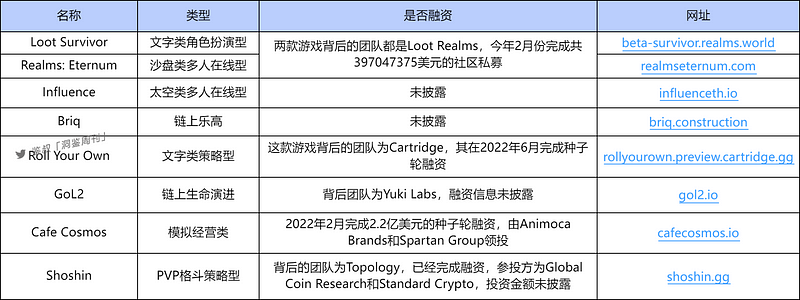
Conclusion and Reflection
At this year's ETHCC, Will Robinson from AllianceDao raised four issues that restrict the development of full-chain games: UX/UI Problems, Uncertain How to Scale, No Standard Design Patterns, and Uncertain Value-Add.
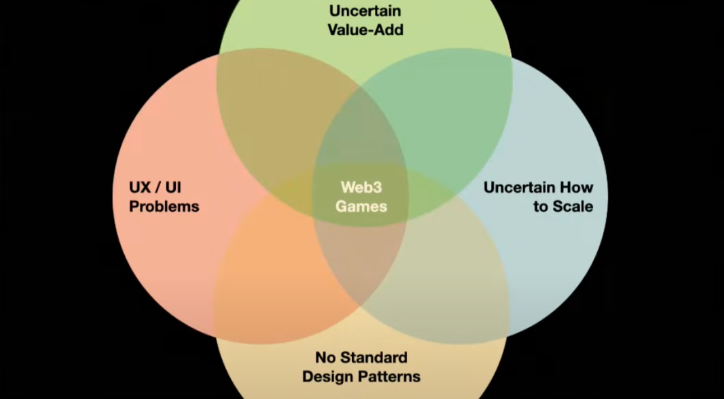
Based on the advantages of Starknet in developing full-chain games mentioned earlier, it can be seen that the first three issues raised by Will Robinson can be effectively addressed in the future. However, regarding the last issue, does full-chain gaming really have value? It is well known that blockchain solves the problem of asset ownership and economic system establishment in the virtual world. So, apart from putting in-game assets on-chain, do we really need to move the entire game operation onto the chain? Does this really make sense for players? This is not a problem unique to Starknet; it is a problem that all participants in the full-chain game ecosystem must face together.
At the end of the article, I want to break free from Starknet and try to answer this question. First, we cannot simply assume that full-chain games are reasonable just because they are conducive to innovation; such reasoning has obvious flaws in logic. As I pondered this, I was inspired by a story about Vitalik.
When he was young, Vitalik was obsessed with playing "World of Warcraft," but he later completely abandoned the game because Blizzard modified the skills of some characters for game balance reasons during an upgrade, which made Vitalik quite angry. After multiple unsuccessful attempts to contact Blizzard's engineers via email, he stopped playing the game altogether. At the same time, he also realized the serious centralization in traditional games, where players have very little say.
Of course, in recent years, players' influence and freedom in traditional games have been increasing, thanks to the widespread adoption of the user-generated content (UGC) concept. However, this level of freedom is clearly not enough; players need true game autonomy. I believe this is the opportunity and significance of full-chain games.
Full-chain games can take UGC to a whole new level. They only build immutable core gameplay on the blockchain and maximize the transfer of game design to players, allowing for unlimited content creation. For example, in the full-chain game Dark Forest, players can do anything they want as long as they follow the most basic rules. For example, they can create their own asset trading market in the game, develop tools to automate their gameplay, or even create new games within the game. Currently, there are nearly a hundred Dark Forest plugins available, allowing players to visualize opponents' territories, automate warfare, and facilitate trading, among other things.
However, this is not the final state of full-chain games, as the aforementioned operations can only be achieved by those with a coding background. But I believe that in the future, ordinary players will also be able to build everything they imagine in full-chain games.
Because I believe, I can see.
Disclaimer: All content on this site may involve project risk factors and is for educational and reference purposes only, and does not constitute any investment advice. Please view it rationally, establish the correct investment concept, and enhance risk awareness. It is recommended to consider various relevant factors before interacting and holding, including but not limited to personal purchasing purposes and risk tolerance.
Copyright Notice: The quoted information belongs to the original media and authors. Without the permission of Jianshu J Club, other media, websites, or individuals may not reprint articles from this site, and Jianshu J Club reserves the right to pursue legal liability for the above actions.
免责声明:本文章仅代表作者个人观点,不代表本平台的立场和观点。本文章仅供信息分享,不构成对任何人的任何投资建议。用户与作者之间的任何争议,与本平台无关。如网页中刊载的文章或图片涉及侵权,请提供相关的权利证明和身份证明发送邮件到support@aicoin.com,本平台相关工作人员将会进行核查。




